The NVIDIA GeForce GTX 660 Review: GK106 Fills Out The Kepler Family
by Ryan Smith on September 13, 2012 9:00 AM ESTOC: Gaming Performance
We’ll keep the running commentary short here, but as we’ll see in our results, power target overclocking alone doesn’t produce a particularly significant result here. Our GTX 660 already runs so close to its maximum boost clock so often that simply allowing it to draw more power doesn’t allow it to clock up all that much higher.
So for significant overclocking we need to turn to utilizing the power target alone with clock offsets. With those offsets in place we’ve increased our power target limits, core clock, and memory clock all by roughly 10%. Overclocked performance as a result is between 8% and 12% better than the stock GTX 660, which for ROP or memory bandwidth-limited game is more than enough to usurp the stock GTX 660 Ti.Meanwhile for games that are heavily shader-bound the 10% overclock will still leave the GTX 660 well behind the stock GTX 660 Ti.
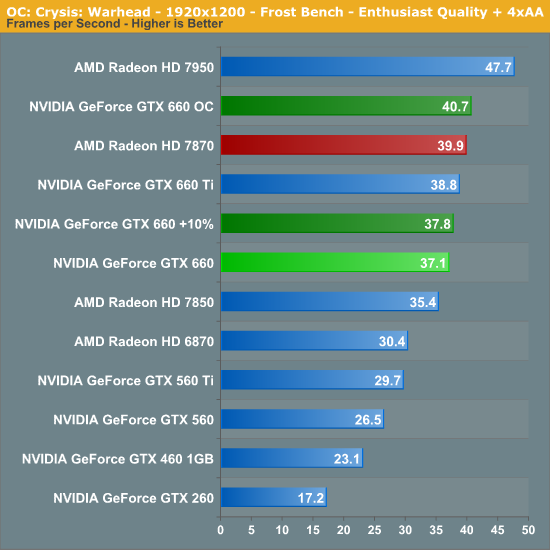
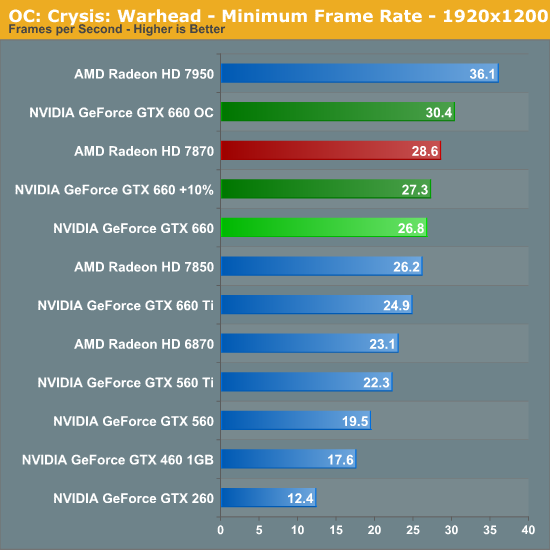
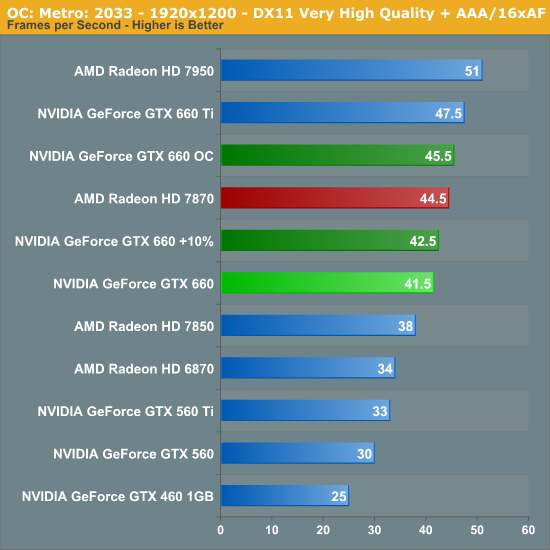
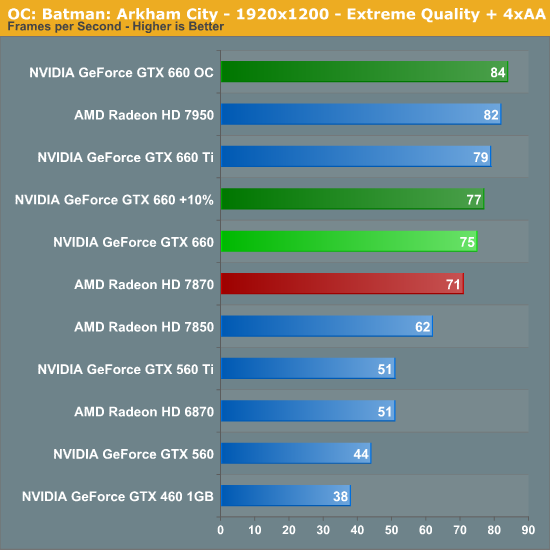

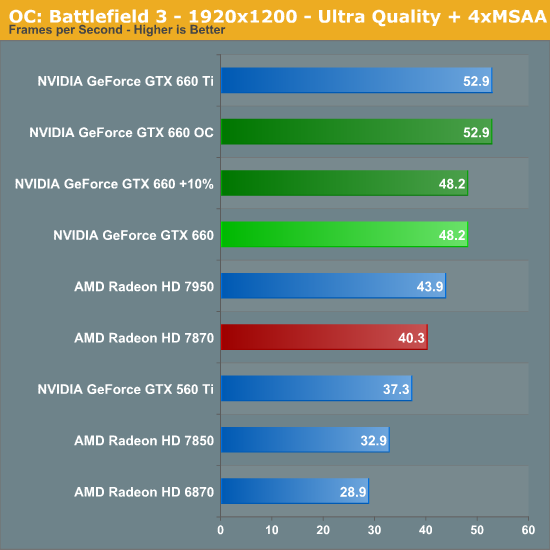











147 Comments
View All Comments
Jumangi - Thursday, September 13, 2012 - link
LOL way to try and spin AMD fanboy. The 660 is the equal of a 7870. It beats it in several tests and loses by a little in others. The $229 price is correct.Go qq somewhere else AMD dude.
Jamahl - Thursday, September 13, 2012 - link
Actually if you read anywhere else you'll find that the 7870 wins by 5-10% in the vast majority of cases.Samus - Thursday, September 13, 2012 - link
I'll take Anandtech reviews over any other reviews. This site has a 15 year reputation for truth.Jamahl - Thursday, September 13, 2012 - link
You do that. Most other people would take the average of all the reviews, and when they did that they'd realise that once again Anandtech is an outlier for Nvidia.rarson - Friday, September 14, 2012 - link
Anandtech lost that reputation years ago when everything started sounding pro-Intel/Nvidia/Apple.RussianSensation - Thursday, September 13, 2012 - link
Raghu78 is actually right."Overall the new ASUS GeForce GTX 660 DirectCU II seems to compete well with a price comparative factory overclocked Radeon HD 7870. While the gameplay experience is mostly the same between the two video cards, for the most part the factory overclocked Radeon HD 7870 seems to take the performance lead. If you look back at every game, the overclocked Radeon HD 7870 is on top in terms of raw performance,"
http://www.hardocp.com/article/2012/09/13/asus_gef...
Given that NV is 7 months late, all they did here was just barely match the price/performance of a 7 months old part. Hard to get excited about that when it's mid-September 2012 and HD8000 series isn't far off now.
HisDivineOrder - Friday, September 14, 2012 - link
Geforce 660 MSRP is $230. Radeon 7870 MSRP is $250. And if you're saying that the Geforce launch is unimpressive then you're probably ignoring the fact that AMD ignored price drops for the 78xx series cards for many, many months and only just when the info about the 660 and 660 Ti began to show up did they start aggressively lowering their pricing.So... what's impressive about nVidia's parts is that they brought competition which drove AMD to lower pricing so much you could today say there's nothing impressive about nVidia's pricing.
And that's what's impressive about it. You should be thanking nVidia for finally showing up to the competition.
Also, saying the "HD8000 series isn't far off now" is disingenuous if that line follows the same model as the 7000 series and staggers the launch so the low end comes midway through or at the end of 1Q 2013. We're not talking about the high end. We're talking about the mainstream variants.
And, if you truly believe your rhetoric, then AMD will price those parts as high or higher than the 78xx series showed up with in order to milk the market while nVidia's not able to keep up. So those cards again won't matter much since they won't be anywhere near the same price as these mid-$200 cards.
We don't even know if AMD won't milk this gen a while longer than they did prior generations because their strategy seems very different than the one they've used for quite a while. And with nVidia coming so late in this gen, AMD might see advantage in riding it out with parity and lower prices (while building up inventory of HD8k) to clean out their old stock.
Then one day after first quarter 2013, WHAM! HD8000 arrives in force. nVidia employees throughout the world look up from typing biased forum posts in every forum you visit and almost weep as cards in every bracket suddenly appear in the marketplace, but then a ray of hope shines through the darkness...
AMD priced everything high again. Angels sing and as Chuck Norris descends upon the clouds of awesomeness and badassness... GK110 arrives in his wake.
Ahhhh... I like this guessing game about what will happen with next gen thing.
raghu78 - Thursday, September 13, 2012 - link
buzz off . the majority of the reviews on the web show the HD 7870 to be faster.http://www.computerbase.de/artikel/grafikkarten/20...
http://ht4u.net/reviews/2012/nvidia_geforce_gtx_66...
http://www.hardware.fr/articles/876-21/recapitulat...
http://www.techpowerup.com/reviews/ASUS/GeForce_GT...
http://www.tomshardware.com/reviews/geforce-gtx-66...
http://www.hardocp.com/article/2012/09/13/asus_gef...
http://www.xbitlabs.com/articles/graphics/display/...
Margalus - Thursday, September 13, 2012 - link
I selected one random choice from your links, techpowerup. Guess what, the page you linked shows the 660 has higher performance per dollar than the 7870 at all resolutions except 2560x1600Galidou - Saturday, September 15, 2012 - link
Fun stuff, he said the ''majority'' and you look at only one of the links he sends. Replying the way you did is a little disrespectful. Next time just write: ''too long didn't read, this card ownz''.